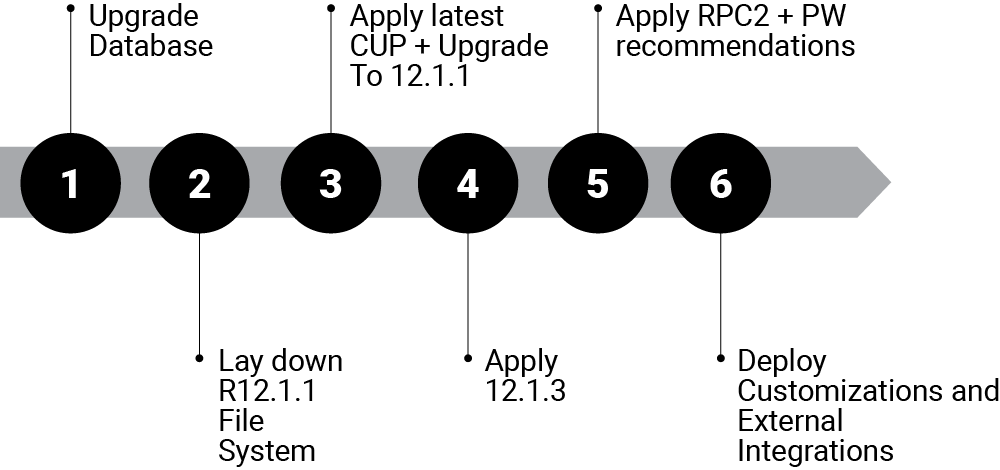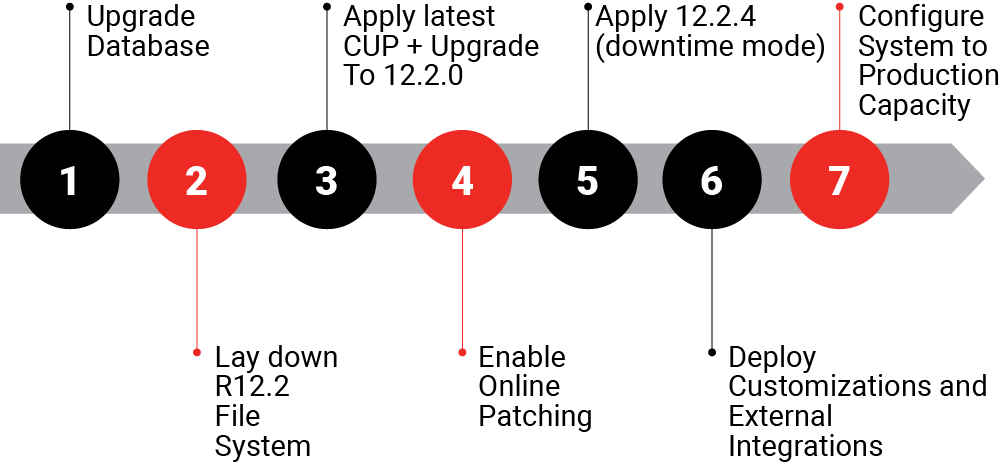Why Upgrading Oracle EBS Matters
The Oracle E-Business Suite (EBS) suite of apps has developed throughout time, but Oracle’s dedication to customers and best-in-class products remains unwavering. E-Business Suite has grown greatly in capability, scalability and user-friendliness over the last few years, including tremendous leaps with the recent Oracle E-Business Suite Release 12.2.12.
Oracle E-Business Suite 12.2 continues to bring new application functionality and improve the capabilities of existing features, while enabling you to take advantage of Oracle Cloud.
There are numerous benefits to upgrading your present Oracle E-Business Suite. For instance:
- Taking advantage of new features and software programs available through an upgrade may help your firm remain competitive by allowing it to use the most up-to-date technology.
- Retiring or reducing customizations and deploying standard processes across your organization may facilitate compliance at a lower cost through upgrading.
- Upgrading allows you to leverage the latest performance and usability enhancements, enabling you to increase the efficiency of your applications utilization and your business.
- You may need to upgrade to remain eligible for the highest product support levels (Premier Support) and regulatory updates.
Oracle EBS 12.2 Upgrade Considerations
There are several aspects to consider while strategizing for any upgrade, such as support timelines, functional capabilities, technological infrastructure and underlying business demands. Identifying the best EBS 12.2 upgrade plan is critical because these criteria are often intertwined.
Oracle E-Business Suite is used by tens of thousands of enterprises worldwide to manage their core business processes. Oracle is dedicated to ensuring the continued success of these enterprises through the delivery of new features and innovations and the provision of long-term Premier Support for Oracle E-Business Suite.
Oracle follows a “Continuous Innovation” strategy when adding new capabilities to Oracle EBS 12.2, giving ongoing updates to apps and the underlying technology stack without the need for a major upgrade. In addition, Oracle E-Business Suite 12.2 offers long-term support, with Premier Support guaranteed through at least 2033.
In tandem with the addition of features to Oracle E-Business Suite products, Oracle is enhancing Oracle EBS so that it may optimally exploit Oracle Cloud Infrastructure and coexist with complementing Oracle SaaS apps.
Customers of Oracle EBS have typically accepted new versions of the technology stack and a new code level for apps via a major release upgrade. This required the use of Oracle’s Rapid Install tool to deploy new versions of Oracle Fusion Middleware platform technologies, a new application code level, and upgrade scripts to migrate the existing schema, PL/SQL, and data to the new Oracle E-Business Suite release level.
The Continuous Innovation release strategy isolates technology stack upgrades from application code updates, allowing E-Business Suite clients to utilize more recent technology while maintaining their existing application code level.
Customers can anticipate the following with Continuous Innovation available for Oracle E-Business Suite 12.2:
- Updates to the Oracle E-Business Suite 12.2 application code on an ongoing basis, similar to the 12.2.x updates that we have made available approximately annually.
- Cumulative updates will integrate bug fixes and new features into a consolidated, suite-wide patch set that can be readily administered using Online Patching.
- Ongoing Technology Stack Updates to enable the required Oracle Fusion Modernization
- Middleware platform technologies serve as the foundation for Oracle E-Business Suite. Customers will be able to get new versions of the technology stack without having to upgrade Oracle EBS application code.
Oracle EBS 12.2 Best Practices
Oracle EBS 12.2 best practices span across the two major efforts involved in this upgrade: the technical and functional efforts. To fully understand what needs to be done, companies must first assess the current state of their application to gauge how many tasks need to be taken care of as part of the upgrade. For example, customizations are one of the biggest reasons why some companies stall their Oracle EBS 12.2 upgrade just for the sheer volume of customizations their Oracle EBS has. Admittedly, it does signify a bigger effort, but with the right partner on deck, it can be an effective, quick, and successful endeavor where most of the customizations can be replaced with standard functionality already present in Oracle EBS 12.2.
In anticipation of the Oracle EBS 12.2 best practices, here’s a high level overview of the upgrade process for companies still running Oracle EBS on 11i:

Next, here’s a high level overview of the 12.2 upgrade process:

Plan, Prepare, and Test
Key to the Oracle EBS 12.2 best practices, planning is a foundational step that sets the tone for how the upgrade will go. As with the majority of planned production maintenance tasks, the success of an update depends heavily on the clarity of the upgrade plan.
Prior to the actual update, it is essential to do pre-production testing and validation on a comparable system in order to minimize unforeseen circumstances.
The key to optimizing the EBS 12.2 upgrade process is making the appropriate decisions during the planning phase and validating these decisions in a test environment before production.
Prepare the Platform and the Database
If a database migration to a new platform is being considered as part of an EBS upgrade, it is encouraged to conduct it first, as customers may often perform it during a separate earlier downtime.
Regardless of whether this migration is performed in a separate previous downtime or as part of a single downtime, performance improvements can be anticipated as a result of the update of the Applications to R12 running on newer and faster hardware.
Also, it’s recommended as part of the Oracle EBS 12.2 best practices, that you plan for the database upgrade as a separate downtime.
Identify Patches and Tasks
Prepare a full list of pre- and post-patches, as well as recommended code levels. Prior to the upgrade, identify and execute tasks that could be completed during a distinct period of downtime. Some more Oracle EBS 12.2 best practices include:
- Reduce the amount of historical data to be upgraded based on business requirements “Upgrade on Demand”
- Upgrade historical data once the system is up (anytime)
- Perform uptime maintenance when possible
- Leverage adpatch options and pre-online patch enablement
Customizations
Customizations, or CEMLIs, are a headache for any company using EBS that is not working with a consultant. Going through each one is time-consuming and prone to errors as it’s hard for untrained eyes or systems to spot which customizations can actually be replaced by standard functionality, which can be completely eliminated, and which need to be migrated successfully.
As part of the Oracle EBS 12.2 best practices, keep in mind that your company should:
- Examine and evaluate customizations that the business may not be using.
- Evaluate new Product Features or New Technologies for Migration.
- Evaluate and disable custom events and triggers.
- Examine and deactivate custom VPD policies as required.
- Evaluate and eliminate custom indexes that are superfluous.
Use “Online Patching readiness Reports” to identify issues in custom database objects that will be fixed automatically vs needing manual intervention. Use the Global Standards compliance checker script to scan your file system custom code and fix reported issues.
For more information about the full upgrade flow, please check out our latest eBook.

